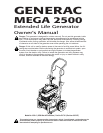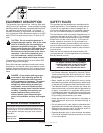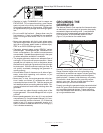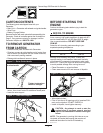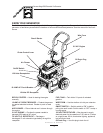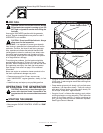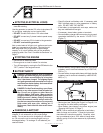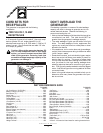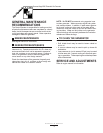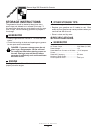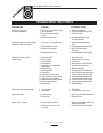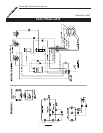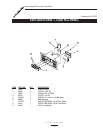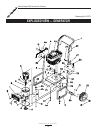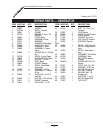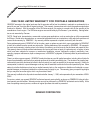
Generac Mega 2500 Extended Life Generator
7
Extended Life Generator
APPLYING ELECTRICAL LOADS
Let engine stabilize and warm up for about five min-
utes after starting.
Use this generator to operate 120 volts, single phase, 60
Hz, ac lighting, appliance, tool and motor loads.
DO NOT connect 240 volts to 120 volts outlets.
DO NOT connect any 3-phase loads to panel recep-
tacles.
DO NOT connect any 50 Hz loads to the generator.
DO NOT overload the generator.
Add up rated watts of all lights, tool, appliance and motor
loads you are powering at one time. This total should
NOT be greater than (a) generators rated wattage
capacity, or (b) circuit breaker rating of the receptacle
supplying power. See Dont Overload the Generator on
Page 8.
STOPPING THE ENGINE
Disconnect all electrical loads
Run engine at no-load for about five minutes,
Turn off the engine by moving the On/Off Switch to the
OFF position. See engine manual.
BATTERY SAFETY
DANGER: Storage batteries give off explosive
hydrogen gas while charging. An explosive mix-
ture will remain around battery for a long time
after it has been charged. The slightest spark
can ignite gas and cause an explosion. Such an
explosion can shatter battery and cause blind-
ness or other serious injury.
DANGER: Do Not Permit smoking, open flame,
sparks or any other source of heat around a bat-
tery. Do not use a lighter or other flame for
checking battery fluid levels. Wear protective
goggles, rubber apron and rubber gloves when
working around a battery. Battery electrolyte
fluid is an extremely caustic sulfuric acid solu-
tion that can cause severe burns. Do not permit
fluid contact with eyes, skin, clothing etc. If
Spill occurs, flush area with clear water imme-
diately.
CHARGING A BATTERY
Your generator has the capability of recharging a dis-
charged 12-volt automotive or utility style storage
battery. Do not use the unit to charge any 6-volt batter-
ies. Do not use the unit to crank an engine having a
discharged battery. To recharge 12-volt batteries, pro-
ceed as follows:
Check fluid level in all battery cells. If necessary, add
ONLY distilled water to cover separators in battery
cells. DO NOT USE TAP WATER.
If the battery is equipped with vent caps, make sure
they are installed and are tight.
If necessary, clean battery posts or terminals.
Connect battery charge cable connector plug to panel
receptacle identified by the words 12-VOLT D.C.
(Figure 7).
Connect battery charge cable clamp with red handle
to battery post or terminal indicated by a POSITIVE,
POS or (+).
Connect battery charge cable clamp with black handle
to battery post or terminal indicated by a NEGATIVE,
NEG, or ().
Start engine (see Starting the Engine on Page 6). Let
the engine run while battery recharges.
When battery has charged, shut down engine (see
Stopping the Engine on Page 7).
NOTE: Use an automotive hydrometer to test battery
state of charge and condition. Follow the hydrometer
manufacturers instructions carefully. Generally, a bat-
tery is considered to be at 100% state of charge when
specific gravity of its fluid (as measured by hydrometer)
is 1.260.
Figure 8 Connect Battery Cables
Figure 7 12 Volt D.C. Receptacle
GENERAC
12VOLT D.C.



